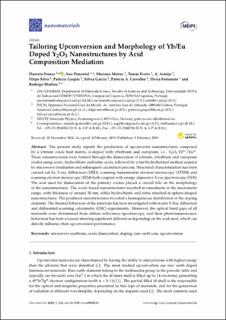| dc.contributor.author | Nunes, Daniela | |
| dc.contributor.author | Pimentel, Ana | |
| dc.contributor.author | Matias, Mariana | |
| dc.contributor.author | Freire, Tomas | |
| dc.contributor.author | Araujo, A | |
| dc.contributor.author | Silva, Filipe | |
| dc.contributor.author | Gaspar, Patricia | |
| dc.contributor.author | Garcia, Silvia | |
| dc.contributor.author | Almeida Carvalho, Patricia | |
| dc.contributor.author | Fortunato, Elvira | |
| dc.contributor.author | Martins, Rodrigo | |
| dc.date.accessioned | 2020-11-26T11:10:47Z | |
| dc.date.available | 2020-11-26T11:10:47Z | |
| dc.date.created | 2019-06-03T14:26:00Z | |
| dc.date.issued | 2019 | |
| dc.identifier.issn | 2079-4991 | |
| dc.identifier.uri | https://hdl.handle.net/11250/2689742 | |
| dc.description.abstract | The present study reports the production of upconverter nanostructures composed by a yttrium oxide host matrix co-doped with ytterbium and europium, i.e., Y2O3:Yb3+/Eu3+. These nanostructures were formed through the dissociation of yttrium, ytterbium and europium oxides using acetic, hydrochloric and nitric acids, followed by a fast hydrothermal method assisted by microwave irradiation and subsequent calcination process. Structural characterization has been carried out by X-ray diffraction (XRD), scanning transmission electron microscopy (STEM) and scanning electron microscopy (SEM) both coupled with energy dispersive X-ray spectroscopy (EDS). The acid used for dissociation of the primary oxides played a crucial role on the morphology of the nanostructures. The acetic-based nanostructures resulted in nanosheets in the micrometer range, with thickness of around 50 nm, while hydrochloric and nitric resulted in sphere-shaped nanostructures. The produced nanostructures revealed a homogeneous distribution of the doping elements. The thermal behaviour of the materials has been investigated with in situ X-Ray diffraction and differential scanning calorimetry (DSC) experiments. Moreover, the optical band gaps of all materials were determined from diffuse reflectance spectroscopy, and their photoluminescence behaviour has been accessed showing significant differences depending on the acid used, which can directly influence their upconversion performance. | en_US |
| dc.language.iso | eng | en_US |
| dc.publisher | MDPI | en_US |
| dc.rights | Navngivelse 4.0 Internasjonal | * |
| dc.rights.uri | http://creativecommons.org/licenses/by/4.0/deed.no | * |
| dc.subject | upconversion | en_US |
| dc.subject | rare earth ions | en_US |
| dc.subject | doping | en_US |
| dc.subject | oxide dissociation | en_US |
| dc.subject | microwave synthesis | en_US |
| dc.title | Tailoring Upconversion and Morphology of Yb/Eu Doped Y2O3 Nanostructures by Acid Composition Mediation | en_US |
| dc.type | Peer reviewed | en_US |
| dc.type | Journal article | en_US |
| dc.description.version | publishedVersion | en_US |
| dc.rights.holder | © 2019 by the authors. Licensee MDPI, Basel, Switzerland. This article is an open access article distributed under the terms and conditions of the Creative Commons Attribution (CC BY) license (http://creativecommons.org/licenses/by/4.0/) | en_US |
| dc.source.pagenumber | 16 | en_US |
| dc.source.volume | 9 | en_US |
| dc.source.journal | Nanomaterials | en_US |
| dc.source.issue | 2 | en_US |
| dc.identifier.doi | 10.3390/nano9020234 | |
| dc.identifier.cristin | 1702344 | |
| dc.relation.project | Norges forskningsråd: 275752 | en_US |
| dc.relation.project | EC/H2020/692373 | en_US |
| dc.relation.project | EC/H2020/685758 | en_US |
| dc.relation.project | NORTEM: 197405 | en_US |
| cristin.unitcode | 7401,80,62,0 | |
| cristin.unitname | Bærekraftig energiteknologi | |
| cristin.ispublished | true | |
| cristin.fulltext | original | |
| cristin.qualitycode | 1 | |

